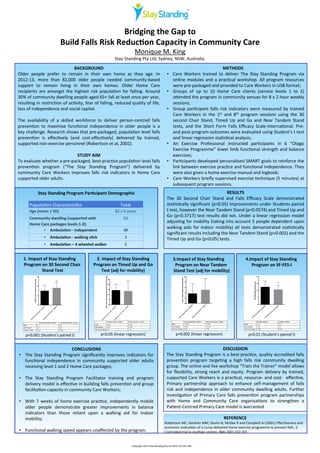
Bridging the Gap to Build Falls Risk Reduction Capacity in Community Care
- 1. BACKGROUND Older people prefer to remain in their own home as they age. In 2012-‐13, more than 82,000 older people needed community-‐based support to remain living in their own homes. Older Home Care recipients are amongst the highest risk populaDon for falling. Around 30% of community dwelling people aged 65+ fall at least once per year, resulDng in restricDon of acDvity, fear of falling, reduced quality of life, loss of independence and social capital. The availability of a skilled workforce to deliver person-‐centred falls prevenDon to maximise funcDonal independence in older people is a key challenge. Research shows that pre-‐packaged, populaDon level falls prevenDon is effecDvely (and cost-‐effecDvely) delivered by trained, supported non-‐exercise personnel (Robertson et al, 2001). STUDY AIM To evaluate whether a pre-‐packaged, best-‐pracDce populaDon level falls prevenDon program (“The Stay Standing Program”) delivered by community Care Workers improves falls risk indicators in Home Care supported older adults. METHODS • Care Workers trained to deliver The Stay Standing Program via online modules and a pracDcal workshop. All program resources were pre-‐packaged and provided to Care Workers in USB format; • Groups of up to 10 Home Care clients (service levels 1 to 2) aZended the program in community venues for 8 x 2 hour weekly sessions; • Group parDcipant falls risk indicators were measured by trained Care Workers in the 1st and 8th program sessions using the 30 second Chair Stand, Timed Up and Go and Near Tandem Stand tests, and the Short Form Falls Efficacy Scale-‐InternaDonal. Pre-‐ and post-‐program outcomes were evaluated using Student’s t test and linear regression staDsDcal analysis; • An Exercise Professional instructed parDcipants in 6 “Otago Exercise Programme” lower limb funcDonal strength and balance exercises; • ParDcipants developed personalised SMART goals to reinforce the link between exercise pracDce and funcDonal independence. They were also given a home exercise manual and logbook; • Care Workers briefly supervised exercise technique (5 minutes) at subsequent program sessions. 4.Impact of Stay Standing Program on SF-‐FES-‐I p<0.01 (Student’s paired t) 3.Impact of Stay Standing Program on Near Tandem Stand Test (adj for mobility) p=0.002 (linear regression) 2. Impact of Stay Standing Program on Timed Up and Go Test (adj for mobility) p<0.05 (linear regression) 1. Impact of Stay Standing Program on 30 Second Chair Stand Test p<0.001 (Student’s paired t) PopulaRon CharacterisRcs Total Age (mean ± SD) 82 ± 6 years Community dwelling (supported with Home Care packages levels 1-‐2): 53 • AmbulaRon -‐ independent 48 • AmbulaRon -‐ walking sRck 3 • AmbulaRon – 4 wheeled walker 2 Bridging the Gap to Build Falls Risk ReducRon Capacity in Community Care Monique M. King Stay Standing Pty Ltd, Sydney, NSW, Australia. Copyright 2015 Stay Standing Pty Ltd ACN 152 542 366 30 Second Chair Stand - Baseline 30 Second Chair Stand – 8 weeks Mean 7.61 8.98 Std. Deviation 3.04 2.88 Std. Error of Mean 0.4257 0.4034 Timed Up and Go -‐ Baseline Timed Up and Go – 8 weeks Mean 14.302 13.528 Std. DeviaRon 5.976 10.738 Std. Error of Mean 0.82 1.39 Near Tandem Stand -‐ Baseline Near Tandem Stand – 8 weeks Mean 14.302 13.528 Std. DeviaRon 5.976 10.738 Std. Error of Mean 0.82 1.39 SF-‐FES(I) -‐ Baseline SF-‐FES(I) – 8 weeks Mean 12.6 10.7 Std. DeviaRon 4.36 3.11 Std. Error of Mean 0.599 0.427 CONCLUSIONS • The Stay Standing Program significantly improves indicators for funcDonal independence in community supported older adults receiving level 1 and 2 Home Care packages; • The Stay Standing Program Facilitator training and program delivery model is effecDve in building falls prevenDon and group facilitaDon capacity in community Care Workers; • With 7 weeks of home exercise pracDce, independently mobile older people demonstrate greater improvements in balance indicators than those reliant upon a walking aid for indoor mobility; • FuncDonal walking speed appears unaffected by the program. DISCUSSION The Stay Standing Program is a best-‐pracDce, quality accredited falls prevenDon program targeDng a high falls risk community dwelling group. The online and live workshop “Train the Trainer” model allows for flexibility, strong reach and equity. Program delivery by trained, supported Care Workers is a pracDcal, resource-‐ and cost-‐ effecDve, Primary partnership approach to enhance self-‐management of falls risk and independence in older community dwelling adults. Further invesDgaDon of Primary Care falls prevenDon program partnerships with Home and Community Care organisaDons to strengthen a PaDent-‐Centred Primary Care model is warranted. REFERENCE Robertson MC, Gardner MM, Devlin N, McGee R and Campbell AJ (2001) EffecDveness and economic evaluaDon of a nurse delivered home exercise programme to prevent falls. 2: Controlled trial in mulDple centres. BMJ 2001;322:701 RESULTS The 30 Second Chair Stand and Falls Efficacy Scale demonstrated staDsDcally significant (p<0.05) improvements under Students paired t test, however the Near Tandem Stand (p=0.0574) and Timed Up and Go (p=0.3717) test results did not. Under a linear regression model adjusDng for mobility (taking into account 5 people dependent upon walking aids for indoor mobility) all tests demonstrated staDsDcally significant results including the Near Tandem Stand (p=0.002) and the Timed Up and Go (p<0.05) tests. Stay Standing Program ParRcipant Demographic
